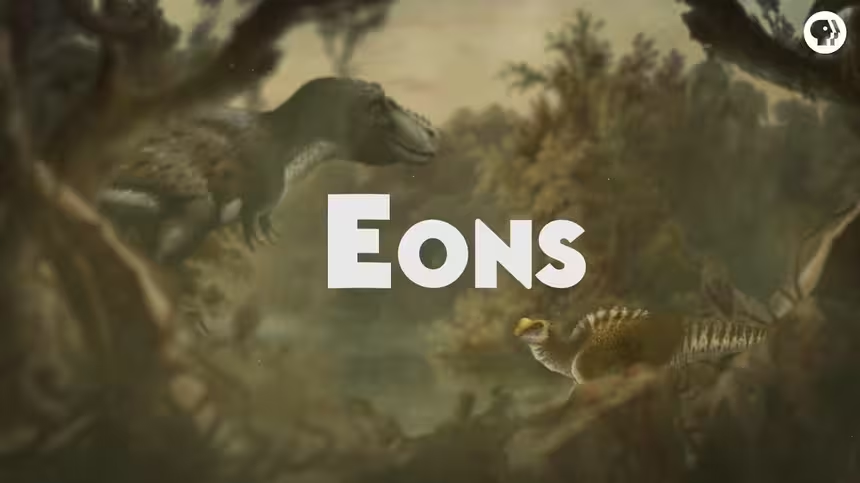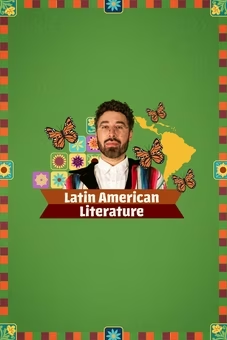
Did Dinosaurs' Extinction Give Us Fruit?
Special | 10m 47sVideo has Closed Captions
One of the most surprising effects of the cascade of changes was...fruit?
One of the most surprising effects of the cascade of changes that played out in the wake of dinosaur extinction may have been the evolution of a world absolutely teeming with fruit. And with all that fruit, came a lot of fruit eaters.
Problems playing video? | Closed Captioning Feedback
Problems playing video? | Closed Captioning Feedback

Did Dinosaurs' Extinction Give Us Fruit?
Special | 10m 47sVideo has Closed Captions
One of the most surprising effects of the cascade of changes that played out in the wake of dinosaur extinction may have been the evolution of a world absolutely teeming with fruit. And with all that fruit, came a lot of fruit eaters.
Problems playing video? | Closed Captioning Feedback
How to Watch Eons
Eons is available to stream on pbs.org and the free PBS App, available on iPhone, Apple TV, Android TV, Android smartphones, Amazon Fire TV, Amazon Fire Tablet, Roku, Samsung Smart TV, and Vizio.

Welcome to Eons!
Join hosts Michelle Barboza-Ramirez, Kallie Moore, and Blake de Pastino as they take you on a journey through the history of life on Earth. From the dawn of life in the Archaean Eon through the Mesozoic Era — the so-called “Age of Dinosaurs” -- right up to the end of the most recent Ice Age.Providing Support for PBS.org
Learn Moreabout PBS online sponsorshipOver 66 million years ago, in a Late Cretaceous聽 forest, the ground rumbled as a giant approached.
A titanosaur measuring nearly 40 meters long聽聽 and weighing around 70 tons came聽 crashing through the vegetation.
The lumbering megaherbivore shattered branches聽 and trunks, trampled ferns and flowers, and broke聽聽 open gaps in the canopy, causing bright beams of聽 sunlight to stream through to the forest floor.
For the poor plants of this ancient forest, this聽 was just another chaotic day in the Mesozoic.
These ancient ecosystems weren’t just ruled by giant dinosaurs,聽聽 they were also constantly being聽 shaped, or engineered by them, too.
Enormous dinosaurs were so widespread and so聽 common for so long that they became a force of聽聽 nature in their own right, having huge impacts聽 on the evolution of the species around them.
And after around 160 million years of聽 giant herbivorous dinosaurs crashing聽聽 through these forests, the plants聽 that lived there had adapted to cope.
Because of the regular disturbance, ancient聽 flowering plants, or angiosperms, mostly evolved聽聽 to play the reproductive odds - producing lots of聽 small seeds with little investment in each one.
But when those giant dinosaurs suddenly聽 disappeared during the K-Pg mass extinction,聽聽 the ecological dynamics of planet聽 Earth were altered forever in ways聽聽 that we’re still feeling the effects of today.
And it seems that one of the most聽 surprising effects of the cascade聽聽 of changes that played out in the聽 wake of their extinction may have聽聽 been the evolution of a new world聽 that was absolutely full of fruit.
And with a lot of fruit,聽 came a lot of fruit eaters.
Now, it’s hard to imagine a world without fruit, but when you think about it, fruit’s very existence is…kinda bizarre.
Fruit is the physical embodiment聽 of an ancient co-evolutionary dance聽聽 between plants and animals that聽 stretches far into the deep past… A colorful, juicy token of friendship emerging聽聽 from a symbiotic relationship at least聽 a hundred million years in the making.
See, plants spend extra energy and聽 resources to develop big seeds with聽聽 nutritious and delicious coatings to attract聽 fruit eaters.
And those fruit eaters,聽聽 in turn, pay the plant back by聽 dispersing the seeds far and wide.
Fruit, then, is a strategy, and it has been so聽 successful in our modern world that scientists聽聽 estimate that in tropical forests today, up to 94%聽 of woody plants produce some kind of fleshy fruit.
And this works so well because most of the聽 animals in those forests have evolved to take聽聽 part in the relationship, becoming at least partly聽 fruit-eating, or frugivorous.
A win-win, right?
Well, like all evolutionary strategies,聽聽 producing fruit only pays off when the聽 ecological circumstances are just right.
And until fairly recently in our planet's history,聽聽 in geological terms, the world聽 simply wasn’t ready for fruit.
Starting in the mid-1980s, researchers聽 hypothesized that the big dinosaurs of聽聽 the Mesozoic Era - the largest megaherbivores聽 to ever walk the earth - acted as powerful聽聽 ecosystem engineers, defining the聽 evolution of the plant life around them.
These researchers argued that the fossil record聽 shows that the reproductive strategy of early聽聽 flowering plants was a response to the chaotic聽 environment of those constantly-disturbed forests.
The plants’ survival strategy was to produce as many offspring as possible in聽聽 the hopes that at least some found the right聽 opportunity to thrive, even if most didn't.
This is what ecologists call ‘r-selection.’ And in the case of flowering plants,聽聽 it meant that seed sizes were聽 often small and fruit was rare.
But after those dinosaurs suddenly went聽 extinct around 66 million years ago,聽聽 the reproductive calculus appears to have shifted.
As forests recovered in the Paleocene,聽 they grew back much denser - finally freed聽聽 from the persistent disturbance聽 of giant herbivorous dinosaurs.
In these new, more stable forests,聽聽 the hypothesis goes angiosperms shifted聽 from r-selection to k-selection.
Which meant that their strategy suddenly聽 became one of increased investment,聽聽 with a decrease in overall quantity.
K-selection is usually something聽 we see in more stable environments.
In these ecological conditions,聽 it’s better to produce fewer, larger seeds, and invest more into each one.
And in the 2000s, other researchers built on聽 this idea, arguing that these denser, darker聽聽 forests of the Paleocene would have also created聽 more competition for light among the plants… See, based on data of carbon聽 isotopes from fossil leaves,聽聽 scientists have estimated that the understory聽 of the more closed-canopy Paleocene forests聽聽 received 19% less light than those聽 more open forests of the Cretaceous.
This would have further selected for the evolution聽聽 of larger seed sizes with bigger聽 energy reserves in the Paleocene.
That strategy gave the next聽 generation an early boost once聽聽 they sprouted – and helped them grow taller to better compete for light.
And with bigger seeds came聽 more fleshy parts coating them,聽聽 which attracted small- to聽 medium-sized animal dispersers.
While some mammals and birds were growing聽 rapidly in size during the Paleocene,聽聽 radiating to fill niches left open聽 by the demise of the dinosaurs,聽聽 they were still pretty puny compared聽 to their reptilian predecessors.
And, in some ways, they would never fully聽 replace the dinosaur megafauna of the Mesozoic.聽聽 Nothing even close to the scale of a giant聽 sauropod would ever be seen again on land.
So, in the millions of years聽 following the extinction event,聽聽 mammals and birds were big enough to effectively聽 disperse the ever-larger seeds of angiosperms.
But they were also still small enough to leave the聽 dense Paleocene forests relatively undisturbed.
All the necessary conditions were now in聽 place.
Earth was finally getting fruity.
And by about 55 to 50 million years ago in聽 the Eocene, the world reached peak fruit.
The extensive tropical forests of the Eocene that聽 stretched as far north as the Arctic supported the聽聽 greatest diversity of seed sizes, fruit sizes,聽 and fruit types in the planet’s entire history.
This, in turn, created entirely new niches聽 for new and bigger fruit-eaters to thrive聽聽 in if they could adapt to rely on these resources.
The earliest fruit-eating seed dispersers聽 included birds and multituberculates - a聽聽 now-extinct group of rodent-like mammals聽 ranging in size from mice to beavers.
And over the next several million years,聽 they were joined by more and more bird and聽聽 mammal lineages that became increasingly聽 reliant on the new abundance of fruit.
Like true rodents, fruit-eating聽 bats, and eventually, us primates.
The story of primate evolution ever since has been聽聽 deeply intertwined with fruit - it’s a topic we’ve covered before on Eons.
But that relationship may have聽 first become cemented in the dark聽聽 forests of the Eocene over 50 million years ago.
Back then, forests heavy with big and聽 fleshy fruits were likely where our聽聽 fruit-eating early primate relatives bounded聽 from tree to tree, and from treat to treat.
Without the cascade of events that led聽 from the extinction of giant dinosaurs聽聽 to the development of these new聽 fruity habitats and resources,聽聽 we primates might never have had a chance to聽 diversify, and you and I would never have evolved.
Now, it can be pretty hard to track聽 exactly how all this played out,聽聽 between the lumbering ecosystem engineers,聽 the forest understory light levels,聽聽 angiosperm seed sizes, and the聽 co-evolution of dispersers.
There were a lot of things going on and the聽聽 fossil record alone can only聽 give you so much information.
So in 2025, researchers created a mathematical聽 model to reconstruct the ecological dynamics聽聽 of these long-term interactions as聽 they played out over geologic time.
Their model was able to explain another聽 phase in the relationship - a reduction聽聽 in average seed size towards the end of聽 the Eocene around 33 million years ago,聽聽 down significantly from its peak earlier on.
This happened as some terrestrial mammals聽 finally got big enough to put the mega back in聽聽 megaherbivore – like the enormous brontotheres, appropriately nicknamed thunder beasts.
The effects that this new wave of megaherbivores聽 had on forest structure finally began to mirror聽聽 the ecological engineering of the giant聽 dinosaurs, albeit on a smaller scale.
And the model also offered two potential聽 predictions about how these dynamics聽聽 may be playing out today, leading to two聽 possible scenarios for the future of fruit.
On the one hand, in recent times, ecosystems聽 have been hemorrhaging big mammals, starting聽聽 with the Pleistocene megafaunal extinction that聽 began about 50,000 years ago and continues today.
In South America for example, the average size of聽聽 medium-to-large sized animals has聽 dropped from 834 kg to just 81 kg,聽聽 through the extinction of megafauna like聽 giant ground sloths and glyptodonts.
Similar patterns have played out around the world,聽聽 mirroring the global loss of giant herbivorous聽 dinosaurs at the end of the Cretaceous.
And the researchers’ model suggests that, over millions of years, this will lead to聽聽 forests developing to be denser and darker聽 once more.
And that could potentially drive聽聽 seed sizes and fruit diversity back聽 up towards their early Eocene peak.
But there's another possibility… See, we humans are now the dominant聽 ecosystem engineers on planet Earth.聽聽 And while there are very few聽 true megaherbivores left,聽聽 we’ve essentially taken over their role in disturbing and opening up forest environments.
So the model suggested that in the long term,聽 the shift in ecological dynamics that we have聽聽 already set in motion could actually lead to聽 a potential drop in average seed size of 60%!
While fruit’s origin is rooted in dinosaurs’ enormous effects on the world around them,聽聽 the future of fruit on planet Earth will depend聽 mostly on the behavior of a much smaller,聽聽


- Science and Nature

A documentary series capturing the resilient work of female land stewards across the United States.












Support for PBS provided by:

